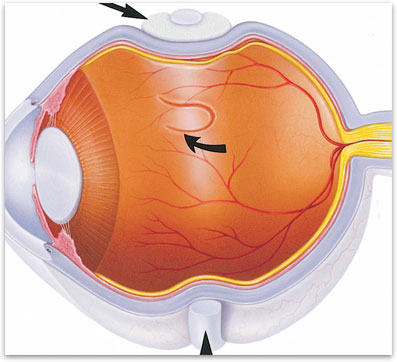Scleral Buckle
What is a Scleral Buckle?
A scleral buckle is a piece of silicone or semi-hard plastic that your retina specialist places around the outside of the eye (figure 1).
When is a Scleral buckle used?
Scleral buckles are typically used to help repair retinal detachments. Scleral buckles can be used alone or in combination with a vitrectomy procedure to repair a retinal detachment.
How is a Scleral buckle placed?
Treatment with a scleral buckle needs to be performed in the operating room. The scleral buckle is placed deep behind the eyelids under the muscles that control eye movement. When placed on the outside of the eye, the scleral buckle creates a slight indentation in the eyewall that moves the eyewall closer to the detached retina. A freezing treatment is usually used to seal the retinal tears. Sometimes the fluid under the detached retina is drained, which allows the retina to fall into its normal position.
How successful is surgery to reattach a retina with a scleral buckle?
Over 98% of retinal detachments can be repaired, 90% of those after a single operation with modern surgical techniques. 10% may require a second operation to completely repair the detached retina. After the retinal detachment is fixed, the vision can take months or years to improve.
In Office Procedures
Intraocular InjectionLaser Surgery
Photodynamic Therapy
Pneumatic Retinopexy
Operating Room Procedures
Vitrectomy SurgeryScleral Buckle

Figure 1. The scleral buckle creates an indentation in the eye wall that helps to repair a retinal detachment.
Will I be able to see the scleral buckle?
No, the scleral buckle is buried deep behind the eyelid and you cannot usually see it. It cannot be seen by others.
Does the scleral buckle ever need to be removed?
The scleral buckle typically remains permanently in place around the outside of the eye. It may slightly change the shape of the eye and, after the eye has healed, a new pair of glasses may be necessary. In a small minority of patients the scleral buckle needs to be removed if it moves or becomes infected.

